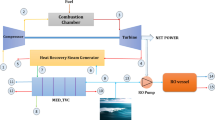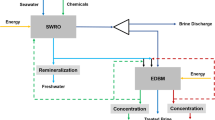Abstract
The problem of ensuring the continuously growing needs of people for freshwater is becoming more acute in Iran. In order to resolve the serious water crisis in arid regions of the country near the Gulf, several desalination units have been used. However, most of the installed units of seawater desalination are based on fossil fuels consumption, which suffers from several disadvantages. According to the demand for clean energy to provide water and electricity, nuclear technology is gaining higher attention as compared to other energy sources. Bushehr NPP as the first commercial nuclear reactor in the country can be included the establishment of a large-scale desalination plant. In this study, after reviewing pertinent aspects of commercial desalination technologies, the history of seawater desalination in Iran is presented. This paper is focused on economic assessment of coupling the Bushehr NPP with different types of desalination systems, namely, Multiple Effect Desalination (MED), Multi-Stage Desalination (MSF), Reverse Osmosis (RO), and RO + MSF, RO + MED (hybrid methods) by using the Desalination Economic Evaluation Program (DEEP) package. By considering the obtained results and advantages of hybrid methods, RO + MED process with thermal/RO ratio of 0.7 and the total capacity of 150 000 m3/day is suggested.






Similar content being viewed by others
Notes
IAEA, Economics of Nuclear Desalination: New Developments and Site-Specific Studies. IAEA, Vienna, 2007.
Sensitive analysis—analysis of the sensitivity of models to changes in their parameters.
REFERENCES
M. Shatat, M. Worrall, and S. Riffat, “Opportunities for solar water desalination worldwide: Review,” Sustainable Cities Soc. 9, 67–80 (2013). https://doi.org/10.1016/j.scs.2013.03.004
World Economic and Social Survey 2011 (UN DESA, New York, 2011).
Desalination by the Numbers (Int. Desalin. Assoc., 2013).
E. Jones, M. Qadir, M. T. H. van Vliet, V. Smakhtin, and S.-M. Kang, “The state of desalination and brine production: A global outlook,” Sci. Total Environ. 657, 1343–1356 (2019). https://doi.org/10.1016/j.scitotenv.2018.12.076
K. Zotalis, E. G. Dialynas, N. Mamassis, and A. N. Angelakis, “Desalination technologies: Hellenic experience,” Water 6, 1134–1150 (2014). https://doi.org/10.3390/w6051134
Nuclear Power in the World Today (World Nucl. Assoc., London, 2014).
P. Compain, “Solar energy for water desalination,” Procedia Eng. 46, 220–227 (2012). https://doi.org/10.1016/j.proeng.2012.09.468
Introduction of Nuclear Desalination (IAEA, Vienna, 2000).
Floating Nuclear Energy Plants for Seawater Desalination (Proc. Technical Committee Meeting, Obninsk, Russia, May 29–31,1995) (IAEA, Vienna, 1995). https://www-pub.iaea.org/MTCD/Publications/PDF/te_0940_scr.pdf.
Advanced Applications of Water Cooled Nuclear Power Plants (IAEA, Vienna, 2008), IAEA-TECDOC-1584. https://pub.iaea.org/MTCD/Publications/PDF/te_1584_ web.pdf.
Safety Aspects of Nuclear Plants Coupled with Seawater Desalination Units (IAEA, Vienna, 2001), IAEA-TECDOC-1235. https://pub.iaea.org/MTCD/publications/ PDF/te_1235_prn.pdf
Economics of Nuclear Power (World Nucl. Assoc., 2017). http://www.worldnuclear.org/information-library/economic-aspects/economicsof-nuclear power.aspx
Technical and Economic Evaluation of Potable Water Production Through Desalination of Seawater by Using Nuclear Energy and Other Means (IAEA, Vienna, 1992), IA-EA‑TECDOC-666. http://iaea.org/inis/co-llection/ NC-LCollectionStore/_Public/24/007/24007848.pdf
Examining the Economics of Seawater Desalination Using the Deep Code (IAEA, Vienna, 2000), IAEA-TECDOC-1186. http://pub.iaea.org/MTCD/publications/ PDF/te_1186_prn.pdf
F. Khalid, I. Dincer, and M. A. Rosen, “Comparative assessment of CANDU 6 and sodium-cooled fast reactors for nuclear desalination,” Desalination 379, 182–192 (2016). https://doi.org/10.1016/j.desal.2015.10.009
M. Y. Park and E. S. Kim, “Thermodynamic evaluation on the integrated system of VHTR and forward osmosis desalination process,” Desalination 337, 117–126 (2014). https://doi.org/10.1016/j.desal.2013.11.023
Y. H. Jung, Y. H. Jeong, J. Choi, A. F. Wibisono, J. I. Lee, and H. C. No, “Feasibility study of a small-sized nuclear heat-only plant dedicated to desalination in the UAE,” Desalination 337, 83–97 (2014). https://doi.org/10.1016/j.desal.2013.11.003
S. Nisan and S. Dardour, “Economic evaluation of nuclear desalination systems,” Desalination 205, 231–242 (2007). https://doi.org/10.1016/j.desal.2006.05.014
G. Alonso, S. Vargas, E. del Valle, and R. Ramirez, “Alternatives of seawater desn usalinatioing nuclear power,” Nucl. Eng. Des. 245, 39–48 (2012). https://doi.org/10.1016/j.nucengdes.2012.01.018
T. Mezher, H. Fath, Z. Abbas, and A. Khaled, “Techno-economic assessment and environmental impacts of desalination technologies,” Desalination 266, 263–273 (2011). https://doi.org/10.1016/j.desal.2010.08.035
M. W. Shahzad, M. Burhan, Li Ang, and Kim Choon Ng, “Energy-water-environment nexus underpinning future,” Desalination 413, 52–64 (2017). https://doi.org/10.1016/j.desal.2017.03.009
A. Cipollina, G. Micale, and L. Rizzuti, Seawater Desalination: Conventional and Renewable Energy Processes (Springer-Verlag, Berlin, 2009). https://doi.org/10.1007/978-3-642-01150-4
B. R. Hughes, F. Reza Zadeh, and H. N. Chaudhry, “Economic viability of incorporating multi-effect distillation with district cooling systems in the United Arab Emirates,” Sustainable Cities Soc. 7, 37–43 (2013).https://doi.org/10.1016/j.scs.2012.10.002
A. Rezaei, A. Naserbeagi, Gh. Alahyarizadeh, and M. Aghaie, “Economic evaluation of Qeshm island MED-desalination plant coupling with different energy sources including fossils and nuclear power plants,” Desalination 422, 101–112 (2017). https://doi.org/10.1016/j.desal.2017.08.016
Renewable Energy in the Water, Energy and Food Nexus: Report (Int. Renewable Energy Agency, 2015). http:// www.irena.org/DocumentDownloads/Publications/ IRENA_Water_Energy_Food_Nexus_2015.pdf
C. Sommariva, Desalination and Advance Water Treatment: Economics and Financing (Balaban, Hopkinton, MA, 2010).
K. Z. Al-Subaie, “Precise way to select a desalination technology,” Desalination 206, 29–35 (2007). https://doi.org/10.1016/j.desal.2006.04.049
M. A. Shannon, P. W. Bohn, M. Elimelech, J. G. Georgiadis, B. J. Mariñas, and A. M. Mayes, “Science and technology for water purification in the coming decades,” Nature 452, 301–310 (2008). https://doi.org/10.1038/nature06599
I. C. Karagiannis and P. G. Soldatos, “Water desalination cost literature: Review and assessment,” Desalination 223, 448–456 (2008). https://doi.org/10.1016/j.desal.2007.02.071
H. Malekinezhad, “Study on the water availability in Iran, using the international water indicators,” in Proc. 8th Int. Congr. on Civil Engineering, Shiraz, Iran, May 11–13,2009 (Dānišgāh Dep. Civil Environ. Eng., Shiraz, 2009). http://iwra.org/member/congress/resource/abs353_article.pdf
N. A. Tir, F. Momeni, and G. T. Boboevich, “Exploring the effects of water sector investment in economic development in Iran,” Procedia - Soc. Behav. Sci. 131, 396–405 (2014).
I. Al-Mutaz, “Hybrid RO MSF: A practical option for nuclear desalination,” Int. J. Nucl. Desalin. 1, 47–57 (2003). https://doi.org/10.1504/IJND.2003.003442
Author information
Authors and Affiliations
Corresponding author
Rights and permissions
About this article
Cite this article
Sadeghi, K., Ghazaie, S.H., Fedorovich, E.D. et al. Economic Assessment of the Possible Desalination Processes for the First Unit of Bushehr Nuclear Power Plant. Therm. Eng. 67, 271–281 (2020). https://doi.org/10.1134/S0040601520050080
Received:
Revised:
Accepted:
Published:
Issue Date:
DOI: https://doi.org/10.1134/S0040601520050080




